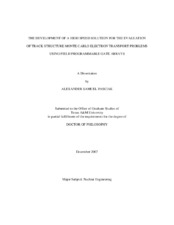| dc.description.abstract | There are two principal techniques for performing Monte Carlo electron transport
computations. The first, and least common, is the full track-structure method. This
method individually models all physical electron interactions including elastic scatter,
electron impact ionization, radiative losses and excitations. However, because of the near
infinite size of electron interaction cross-sections and highly anisotropic scattering
behavior, this method requires an enormous amount of computation time. Alternatively,
the Condensed History (CH) method for electron transport lumps the average effects of
multiple energy loss and scattering events into one single pseudo-event, or step. Because
of this approximation, the CH method can be orders of magnitude faster than the trackstructure
method. While the CH method is reasonably accurate in many situations, it can
be inaccurate for simulations involving microscopic site sizes such as those often found
in radiation biology. For radiation biology and other microdosimetry applications, a
computational device called a Field Programmable Gate Array (FPGA) is capable of
executing track-structure Monte Carlo electron transport simulations as fast as, or faster
than a standard computer performing transport via the CH method—and, it does so with
the additional accuracy and level of detail provided by the track-structure method. In this
dissertation, data from FPGA based track-structure electron transport computations are
presented for five test cases, ranging in complexity from simple slab-style geometries to
radiation biology applications involving electrons incident on endosteal bone surface
cells. Even for the most complex test case presented, an FPGA is capable of evaluating
track-structure electron transport problems more than 500 times faster than a standard computer can perform the same track-structure simulation, and with comparable
accuracy. | en |


